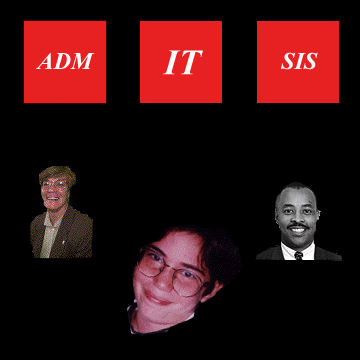Instructional Technology .... Teasing out a District's
Pathology
Technology Conference
Lewis & Clark Community College - October 24, 1997
Richard
Wertheimer
/projects/ckp/publications/presentations/talk14.html
The Common Knowledge: Pittsburgh (CK:P) project has the following goals:
- Teaching Environment - The network shall enhance the
teaching environment for all teachers in the Pittsburgh Public Schools
by expanding the personal contacts and information resources available
to these teachers.
- Curriculum Development - The network shall be available to
serve the development of curricular activities of the Pittsburgh Public
Schools in all subject areas and at all grade levels.
- Access to Information - The network shall provide
information services not currently available to the Pittsburgh school
system.
- School Restructuring - The network shall serve as a
tool in the restructuring efforts of the Pittsburgh Public Schools.
- A National Model - The network and its associated curricular
activities shall serve as a national model for the implementation of
wide area networks in the K12 environment.
The National Science Foundation funded the project in two stages. The
first stage was an initial two year
grant
to research the viability of the Internet in K12 education. The
second was a three year
grant to research the Pittsburgh Public Schools'
ability to institutionalize the lessons learned through CK:P.
We are in the last year of the project. And although it is premature to
suggest that the project has been an outright success, there are strong
indicators that it did achieve many of its goals.
- The Pittsburgh Public Schools just passed a
Technology Plan
that builds on the lessons learned from Common Knowledge: Pittsburgh.
- Access in the school district is growing. Any staff member can have
an email account and access the Internet from home or school. Out of a
total of 90 schools, 5,000 staff and 40,000 students there are:
- 3,000 staff email accounts
- 1,800 student email accounts
- 29 schools with LAN and ISDN access obtained through CK:P
- 10 schools with LAN and ISDN access obtained through their own
efforts and
- 40 schools with dialup access.
- There are many powerful examples
of network applications in curriculum, instruction and assessment.
Our experience suggests
that Instructional Technology (and the Internet) can be a powerful
catalyst for school reform. Access to the Internet, with adequate
support, can democratize education.
It reduces teacher and student isolation by breaching the classroom walls
making Internet resources available to all students and teachers no
matter what their income, status, or expertise. As such, it flattens the
bureaucratic pyramid, making learners of us all.
Our experience also suggests that implementing
instructional technology causes anger, insight, creativity,
political struggles, frustration, and empowerment (i.e.pathology).
| The Players |
 |
|---|
|
| Elements of
District Pathology |
|---|
|
- Change - implementing instructional technology - occurs through a
complex interaction initiated by a catalyst , played out in the context of
an organization and addressing the needs
of the individuals.
- The behaviors which result during any change effort are dependent upon
two key elements - the initial conditions that staff and organization
find themselves in at the moment the catalyst is introduced and
the alignment of the catalyst with the needs of the
organization and its individuals.
- Educators who initiate a change process must be sensitive to
individual and cultural issues. They must understand the
local culture and see the process of change from a variety of
perspectives.
- Those who initiate a change process must either have an
advocate on the policy level or be willing to enter the political
process and promote the change from within.
- There must be a set of
guiding principals that will steer the
reform effort.
Personal Variables
These variables correspond to personal needs. Since each individual
perceives change efforts in their own way, and each has different
experiences and abilities, it is a challenge to predict the
effects of a catalyst on the many individuals that make up the
organization. Personal variables include:
Cultural Variables
Cultural variables, in a school district, pertain to the rules or mores
the organization and its members create and use. These provide the context
within which change can occur.
Catalysts
These are change agents which are introduced into the system.
1
For a theoretical discussion pertaining to district pathology, see:
Attending to the Noise: Applying Chaos Theory to School Reform.
Presented at the 1997 annual conference of the American Educational
Research Association.
Common Knowledge:
Pittsburgh
515 North Highland Avenue
Pittsburgh, Pennsylvania 15206-2598
Voice (412) 665-2230
Fax (412) 665-2235
email - info@pps.pgh.pa.us